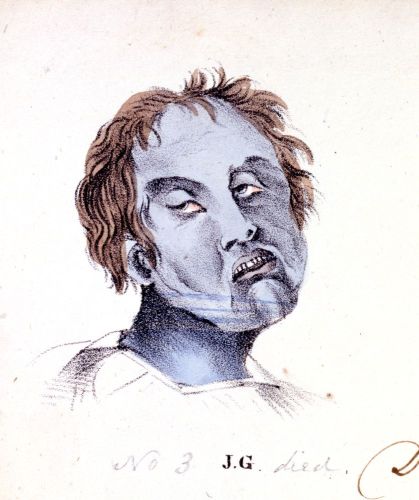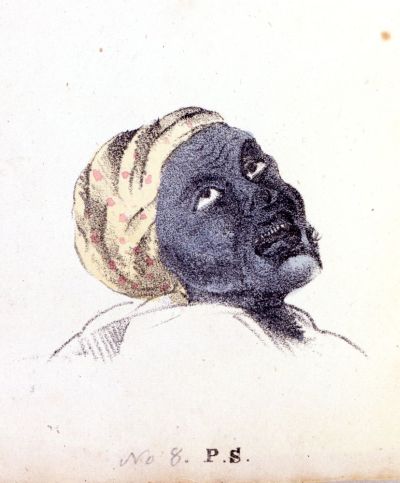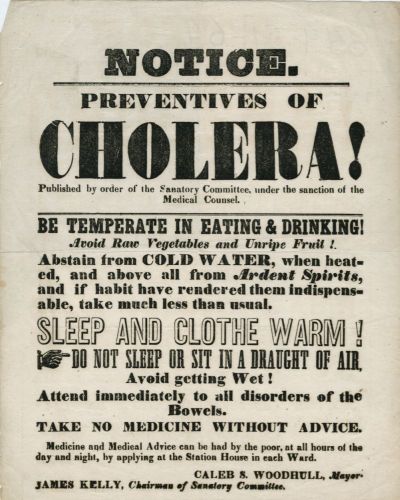Children find play even in the most tragic events. Many believe the universal nursery rhyme “Ring Around the Rosey” to have originated in London, where the Great Plague of 1665-66 killed upwards of 75,000 people (“ashes to ashes, we all fall down!”). On Saturday, August 25, 1849 the Brooklyn Daily Eagle reported on local children who responded to that summer’s cholera epidemic by making up a game:
Playing Cholera
April 16th, 2008How Epidemics Helped Shape the Modern Metropolis
April 15th, 2008The New York Times today, April 15th, 2008, explores the exhibition, Plague in Gotham! and the Weekend with History session with Dr. David Ho & Dr. Kenneth Jackson, who discussed the connection between the Cholera epidemics of the 19th century and the present-day AIDS epidemic. Reporter John Noble Wilford explores How Epidemics Helped Shape the Modern Metropolis, and science editor David Corcoran talks with co-curator Stephen Edidin about the exhibition in this week’s Science Times podcast.
“Fever in New York” – A N-YHS Weekend with History session featuring Dr. David Ho & Dr. Kenneth Jackson
April 15th, 2008On April 5th, 2008, at a session during the Weekend with History at the New-York Historical Society, Dr. David Ho and Dr. Kenneth Jackson discussed the connection between the Cholera epidemics of the 19th century, and the present-day AIDS epidemic.
Speakers: Dr. David D. Ho, Scientific Director and CEO of the Aaron Diamond AIDS Research Center and Irene Diamond Professor, The Rockefeller University. Dr. Kenneth T. Jackson, Jacques Barzun Professor of History and the Social Sciences and Director of the Herbert H. Lehman Center for American History, Columbia University.
(*note* The book Dr. Jackson is referring to in the beginning of the session is Charles E Rosenberg’s The Cholera Years)
Obsolete Medical Terms
April 12th, 2008Ever had a “furuncle”? Perhaps felt a touch of “asthenia”? Or maybe “scrofula”? Like “cholera,” these terms were once commonly used by our ancestors, but are rarely heard today. To find out what they mean, visit this list of archaic medical terms, or this one, or this Glossary of Ancient Diseases.
Faces of Cholera: “J.G.” and “P.S.”
April 3rd, 2008By September 1832 some 2,030 patients had been treated in New York City’s cholera hospitals. These public institutions-hastily established because private hospitals refused entry to cholera victims-were makeshift at best: a requisitioned bank, a school, and a windowless workshop into which “winds and rain were freely admitted” before carpenters “could be induced to work among the sick and dying.” Of the 410 patients admitted to the cholera hospital on Rivington Street, 179, or just over 43%, died.
The images below, with their accompanying case studies — two of several from Horatio Bartley’s llustrations of Cholera Asphyxia in its Different Stages, Selected From Cases Treated at the Cholera Hospital, Rivington Street (New York: S.H. Jackson, 1832) — provide a unique view of the plight of those unfortunate enough to have contracted the disease.
“J.G. aged thirty-one, admitted six o’clock, P.M. July 17th, 1832, in the stage of collapse. Was rubbed with camphorated mercurial ointment, until reaction was produced; he was then put under hospital treatment. 22d. Ptyalism [excessive salivation] being induced, was ordered small doses of sulphur, and a wash of the same for the mouth. At six o’clock P.M. diarrhea increasing, was ordered an anodyne enema. He was under medical treatment until 24th, when he died, at three o’clock, P.M.”
“P.S. aged 33, intemperate Negro. Admitted 4th of August 8 o’clock P.M. Was attacked with diarrhea and vomiting, 2 days ago. When brought in was cold at the surface; pulseless; hands shriveled; eyes sunken. He underwent medical treatment until 6 o’clock A.M. on the 9th August, and died after an illness of four days and a quarter.”
Spreading the word
April 3rd, 2008This broadside announcement reflects the limited extent of medical knowledge of the causes of cholera during the first half of the nineteenth century. Although issued in 1849 during New York’s second cholera epidemic, it is virtually identical to the preventive information circulated in 1832 when the city first encountered the disease.
New York City in 1832
April 3rd, 2008The New York of 1832 was a city clustered on the streets of lower Manhattan. Most roads above 14th Street existed only as projections on paper until a rapidly growing population forced their opening. Developments below 14th Street were products of earlier thrusts northward by citizens who transformed the landscape into the areas we no know as Greenwich Village, Soho, TriBeCa, Chinatown, and the Lower East Side. The different colored sections on the map below denote the city’s wards, or political units.
William Hooker, Map of the City of New York, Compiled and Engraved…Expressly for the Series of Views Illustrating the City of New York and its Environs, Now Publishing (New York: Peabody & Co., [1832]).
Explore some points of interest to the story of cholera in 19th-century
Plague in Gotham! VODcast
April 3rd, 2008Stephen Edidin, Curator of American and European Art at the New-York Historical Society, discusses the use of paintings in the exhibition to explore the topic of cholera in the 19th century.




